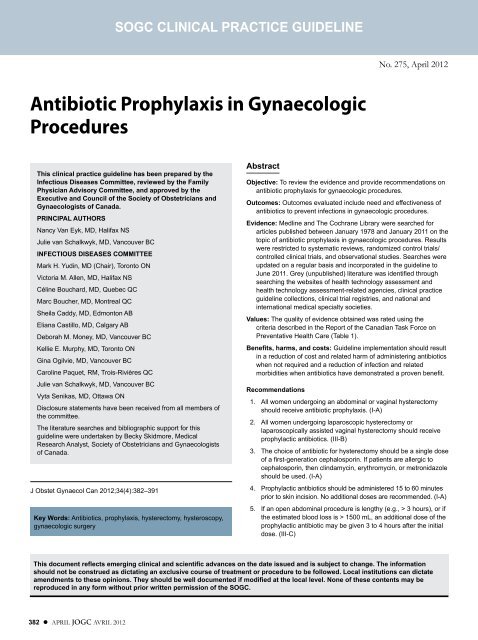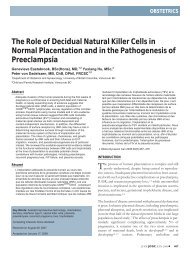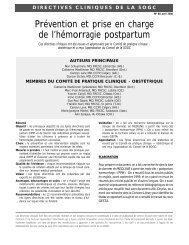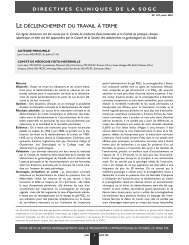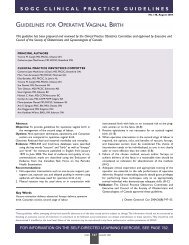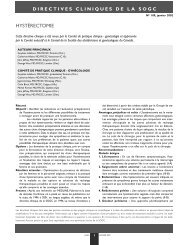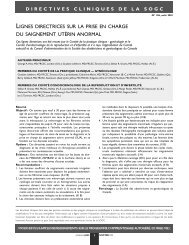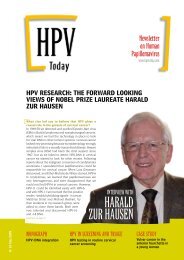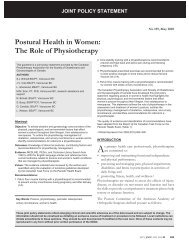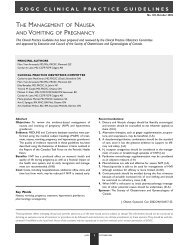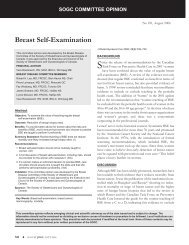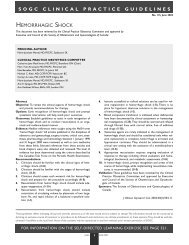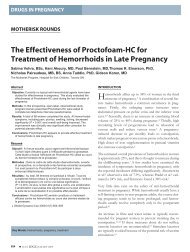Antibiotic Prophylaxis in Gynaecologic Procedures - SOGC
Antibiotic Prophylaxis in Gynaecologic Procedures - SOGC
Antibiotic Prophylaxis in Gynaecologic Procedures - SOGC
You also want an ePaper? Increase the reach of your titles
YUMPU automatically turns print PDFs into web optimized ePapers that Google loves.
J Obstet Gynaecol Can 2012;34(4):382–391<br />
382 l APRIL JOGC AVRIL 2012<br />
<strong>SOGC</strong> CLINICAL PRACTICE GUIDELINE<br />
<strong>Antibiotic</strong> <strong>Prophylaxis</strong> <strong>in</strong> <strong>Gynaecologic</strong><br />
<strong>Procedures</strong><br />
This cl<strong>in</strong>ical practice guidel<strong>in</strong>e has been prepared by the<br />
Infectious Diseases Committee, reviewed by the Family<br />
Physician Advisory Committee, and approved by the<br />
Executive and Council of the Society of Obstetricians and<br />
Gynaecologists of Canada.<br />
PRINCIPAL AUTHORS<br />
Nancy Van Eyk, MD, Halifax NS<br />
Julie van Schalkwyk, MD, Vancouver BC<br />
INFECTIOUS DISEASES COMMITTEE<br />
Mark H . Yud<strong>in</strong>, MD (Chair), Toronto ON<br />
Victoria M . Allen, MD, Halifax NS<br />
Cél<strong>in</strong>e Bouchard, MD, Quebec QC<br />
Marc Boucher, MD, Montreal QC<br />
Sheila Caddy, MD, Edmonton AB<br />
Eliana Castillo, MD, Calgary AB<br />
Deborah M . Money, MD, Vancouver BC<br />
Kellie E . Murphy, MD, Toronto ON<br />
G<strong>in</strong>a Ogilvie, MD, Vancouver BC<br />
Carol<strong>in</strong>e Paquet, RM, Trois-Rivières QC<br />
Julie van Schalkwyk, MD, Vancouver BC<br />
Vyta Senikas, MD, Ottawa ON<br />
Disclosure statements have been received from all members of<br />
the committee .<br />
The literature searches and bibliographic support for this<br />
guidel<strong>in</strong>e were undertaken by Becky Skidmore, Medical<br />
Research Analyst, Society of Obstetricians and Gynaecologists<br />
of Canada .<br />
Key Words: <strong>Antibiotic</strong>s, prophylaxis, hysterectomy, hysteroscopy,<br />
gynaecologic surgery<br />
Abstract<br />
No. 275, April 2012<br />
Objective: To review the evidence and provide recommendations on<br />
antibiotic prophylaxis for gynaecologic procedures .<br />
Outcomes: Outcomes evaluated <strong>in</strong>clude need and effectiveness of<br />
antibiotics to prevent <strong>in</strong>fections <strong>in</strong> gynaecologic procedures .<br />
Evidence: Medl<strong>in</strong>e and The Cochrane Library were searched for<br />
articles published between January 1978 and January 2011 on the<br />
topic of antibiotic prophylaxis <strong>in</strong> gynaecologic procedures . Results<br />
were restricted to systematic reviews, randomized control trials/<br />
controlled cl<strong>in</strong>ical trials, and observational studies . Searches were<br />
updated on a regular basis and <strong>in</strong>corporated <strong>in</strong> the guidel<strong>in</strong>e to<br />
June 2011 . Grey (unpublished) literature was identified through<br />
search<strong>in</strong>g the websites of health technology assessment and<br />
health technology assessment-related agencies, cl<strong>in</strong>ical practice<br />
guidel<strong>in</strong>e collections, cl<strong>in</strong>ical trial registries, and national and<br />
<strong>in</strong>ternational medical specialty societies .<br />
Values: The quality of evidence obta<strong>in</strong>ed was rated us<strong>in</strong>g the<br />
criteria described <strong>in</strong> the Report of the Canadian Task Force on<br />
Preventative Health Care (Table 1) .<br />
Benefits, harms, and costs: Guidel<strong>in</strong>e implementation should result<br />
<strong>in</strong> a reduction of cost and related harm of adm<strong>in</strong>ister<strong>in</strong>g antibiotics<br />
when not required and a reduction of <strong>in</strong>fection and related<br />
morbidities when antibiotics have demonstrated a proven benefit .<br />
Recommendations<br />
01 . All women undergo<strong>in</strong>g an abdom<strong>in</strong>al or vag<strong>in</strong>al hysterectomy<br />
should receive antibiotic prophylaxis . (I-A)<br />
02 . All women undergo<strong>in</strong>g laparoscopic hysterectomy or<br />
laparoscopically assisted vag<strong>in</strong>al hysterectomy should receive<br />
prophylactic antibiotics . (III-B)<br />
03 . The choice of antibiotic for hysterectomy should be a s<strong>in</strong>gle dose<br />
of a first-generation cephalospor<strong>in</strong> . If patients are allergic to<br />
cephalospor<strong>in</strong>, then cl<strong>in</strong>damyc<strong>in</strong>, erythromyc<strong>in</strong>, or metronidazole<br />
should be used . (I-A)<br />
04 . Prophylactic antibiotics should be adm<strong>in</strong>istered 15 to 60 m<strong>in</strong>utes<br />
prior to sk<strong>in</strong> <strong>in</strong>cision . No additional doses are recommended . (I-A)<br />
05 . If an open abdom<strong>in</strong>al procedure is lengthy (e .g ., > 3 hours), or if<br />
the estimated blood loss is > 1500 mL, an additional dose of the<br />
prophylactic antibiotic may be given 3 to 4 hours after the <strong>in</strong>itial<br />
dose . (III-C)<br />
This document reflects emerg<strong>in</strong>g cl<strong>in</strong>ical and scientific advances on the date issued and is subject to change. The <strong>in</strong>formation<br />
should not be construed as dictat<strong>in</strong>g an exclusive course of treatment or procedure to be followed. Local <strong>in</strong>stitutions can dictate<br />
amendments to these op<strong>in</strong>ions. They should be well documented if modified at the local level. None of these contents may be<br />
reproduced <strong>in</strong> any form without prior written permission of the <strong>SOGC</strong>.
06 . <strong>Antibiotic</strong> prophylaxis is not recommended for laparoscopic<br />
procedures that <strong>in</strong>volve no direct access from the abdom<strong>in</strong>al<br />
cavity to the uter<strong>in</strong>e cavity or vag<strong>in</strong>a . (l-E)<br />
07 . All women undergo<strong>in</strong>g surgery for pelvic organ prolapse and/or<br />
stress ur<strong>in</strong>ary <strong>in</strong>cont<strong>in</strong>ence should receive a s<strong>in</strong>gle dose of firstgeneration<br />
cephalospor<strong>in</strong> . (III-B)<br />
08 . <strong>Antibiotic</strong> prophylaxis is not recommended for hysteroscopic<br />
surgery . (II-2D)<br />
09 . All women undergo<strong>in</strong>g an <strong>in</strong>duced (therapeutic) surgical abortion<br />
should receive prophylactic antibiotics to reduce the risk of postabortal<br />
<strong>in</strong>fection . (I-A)<br />
10 . Prophylactic antibiotics are not suggested to reduce <strong>in</strong>fectious<br />
morbidity follow<strong>in</strong>g surgery for a missed or <strong>in</strong>complete<br />
abortion . (I-E)<br />
11 . <strong>Antibiotic</strong> prophylaxis is not recommended for <strong>in</strong>sertion of an<br />
<strong>in</strong>trauter<strong>in</strong>e device . (I-E) However, health care professionals<br />
could consider screen<strong>in</strong>g for sexually transmitted <strong>in</strong>fections <strong>in</strong><br />
high-risk populations . (III-C)<br />
12 . There is <strong>in</strong>sufficient evidence to support the use of antibiotic<br />
prophylaxis for an endometrial biopsy . (III-L)<br />
13 . The best method to prevent <strong>in</strong>fection after hysterosalp<strong>in</strong>gography<br />
is unknown . Women with dilated tubes found at the time of<br />
hysterosalp<strong>in</strong>gography are at highest risk, and prophylactic<br />
antibiotics (e .g ., doxycycl<strong>in</strong>e) should be given . (II-3B)<br />
14 . <strong>Antibiotic</strong> prophylaxis is not recommended for urodynamic<br />
studies <strong>in</strong> women at low risk, unless the <strong>in</strong>cidence of ur<strong>in</strong>ary<br />
tract <strong>in</strong>fection post-urodynamics is > 10% . (1-E)<br />
15 . In patients with morbid obesity (BMI > 35 kg/m2 ), doubl<strong>in</strong>g the<br />
antibiotic dose may be considered . (III-B)<br />
16 . Adm<strong>in</strong>istration of antibiotics solely to prevent endocarditis is<br />
not recommended for patients who undergo a genitour<strong>in</strong>ary<br />
procedure . (III-E)<br />
INTRODUCTION<br />
Infectious complications follow<strong>in</strong>g gynaecologic surgical<br />
procedures are a significant source of morbidity and<br />
potential mortality. They <strong>in</strong>clude ur<strong>in</strong>ary tract <strong>in</strong>fection,<br />
endometritis, wound <strong>in</strong>fection, vag<strong>in</strong>al cuff cellulitis, per<strong>in</strong>eal<br />
<strong>in</strong>fection, and sepsis, which lead to prolonged hospital stays and<br />
<strong>in</strong>creased health care costs. Much work has been done to study<br />
the effect of prophylactic antibiotics <strong>in</strong> reduc<strong>in</strong>g <strong>in</strong>fectious<br />
morbidity. A plethora of antibiotic types, dos<strong>in</strong>g schedules,<br />
and routes of adm<strong>in</strong>istration have been <strong>in</strong>vestigated. There<br />
is evidence to support the use of prophylactic antibiotics for<br />
a number of procedures <strong>in</strong> gynaecology. Unfortunately, few<br />
comparative trials have been conducted, leav<strong>in</strong>g the cl<strong>in</strong>ician<br />
with uncerta<strong>in</strong>ty as to which regimen is superior.<br />
ABBREVIATIONS<br />
BV bacterial vag<strong>in</strong>osis<br />
HSG hysterosalp<strong>in</strong>gography<br />
PID pelvic <strong>in</strong>flammatory disease<br />
STI sexually transmitted <strong>in</strong>fection<br />
UTI ur<strong>in</strong>ary tract <strong>in</strong>fection<br />
<strong>Antibiotic</strong> <strong>Prophylaxis</strong> <strong>in</strong> <strong>Gynaecologic</strong> <strong>Procedures</strong><br />
The presence of antibiotic resistant organisms is a reality<br />
<strong>in</strong> Canadian health care facilities. 1 These organisms <strong>in</strong>clude<br />
methicill<strong>in</strong> resistant Staphylococcus aureus, vancomyc<strong>in</strong><br />
resistant Enterococcus, and extended-spectrum betalactamase-produc<strong>in</strong>g<br />
organisms.<br />
Both morbidity and mortality are <strong>in</strong>creased <strong>in</strong> <strong>in</strong>fections<br />
<strong>in</strong>volv<strong>in</strong>g these organisms, as they may be more virulent and<br />
are more difficult to treat because therapeutic options are<br />
limited. <strong>Antibiotic</strong> resistance development results ma<strong>in</strong>ly<br />
from the <strong>in</strong>appropriate use of antibiotics. Incomplete<br />
courses of antibiotic therapies and the unnecessary use<br />
of broader spectrum regimens play a role. 2 Adherence<br />
to treatment and prophylaxis guidel<strong>in</strong>es likely assists <strong>in</strong><br />
reduc<strong>in</strong>g <strong>in</strong>fection and antibiotic resistance. Physician<br />
adherence to antibiotic prophylaxis guidel<strong>in</strong>es is variable<br />
and frequently at odds with published guidel<strong>in</strong>es. 3,4<br />
In addition to antibiotic prophylaxis, all factors that<br />
affect <strong>in</strong>fectious risk reduction <strong>in</strong> our specialty must<br />
be reviewed. Sterile surgical fields must be ensured, and<br />
ongo<strong>in</strong>g quality assessment of sterilization technique, air<br />
ventilation, and postoperative wound care are needed.<br />
Consistent <strong>in</strong>fection control surveillance and report<strong>in</strong>g of<br />
<strong>in</strong>fectious complications track ability to m<strong>in</strong>imize these<br />
morbidities and possibly to identify clusters of <strong>in</strong>fection<br />
and the emergence of antibiotic resistant organisms. This<br />
will dictate changes to operative rout<strong>in</strong>es to respond to<br />
evolv<strong>in</strong>g microbial diversity that seems <strong>in</strong>evitable.<br />
PRINCIPLES OF ANTIBIOTIC PROPHYLAXIS<br />
The purpose of antibiotic prophylaxis <strong>in</strong> surgical procedures<br />
is not to sterilize tissues but to reduce the colonization<br />
pressure of microorganisms <strong>in</strong>troduced at the time of<br />
operation to a level that the patient’s immune system is<br />
able to overcome. 5 <strong>Prophylaxis</strong> does not prevent <strong>in</strong>fection<br />
caused by postoperative contam<strong>in</strong>ation. Prophylactic<br />
antibiotic use differs from treatment with antibiotics <strong>in</strong><br />
that the former is <strong>in</strong>tended to prevent <strong>in</strong>fection, whereas<br />
the latter is <strong>in</strong>tended to resolve an established <strong>in</strong>fection,<br />
typically requir<strong>in</strong>g a longer course of therapy. <strong>Prophylaxis</strong><br />
is <strong>in</strong>tended for elective procedures <strong>in</strong> which the <strong>in</strong>cision<br />
will be closed <strong>in</strong> the operat<strong>in</strong>g room.<br />
Before an agent can be considered for use as a prophylactic,<br />
there must be evidence that it reduces postoperative<br />
<strong>in</strong>fection. It must also be safe and <strong>in</strong>expensive, and it must<br />
be effective aga<strong>in</strong>st organisms likely to be encountered <strong>in</strong><br />
the surgical procedure. The agent must be adm<strong>in</strong>istered<br />
<strong>in</strong> a way that ensures that serum and tissue levels are<br />
adequate before an <strong>in</strong>cision is made and that therapeutic<br />
levels of the agent can be ma<strong>in</strong>ta<strong>in</strong>ed <strong>in</strong> serum and tissue<br />
APRIL JOGC AVRIL 2012 l 383
<strong>SOGC</strong> CLINICAL PRACTICE GUIDELINE<br />
Table 1. Key to evidence statements and grad<strong>in</strong>g of recommendations, us<strong>in</strong>g the rank<strong>in</strong>g of the Canadian Task Force<br />
on Preventive Health Care<br />
Quality of evidence assessment* Classification of recommendations†<br />
I: Evidence obta<strong>in</strong>ed from at least one properly randomized A . There is good evidence to recommend the cl<strong>in</strong>ical preventive action<br />
controlled trial<br />
II-1: Evidence from well-designed controlled trials without<br />
B . There is fair evidence to recommend the cl<strong>in</strong>ical preventive action<br />
randomization<br />
II-2: Evidence from well–designed cohort (prospective or<br />
retrospective) or case–control studies, preferably from<br />
more than one centre or research group<br />
II-3: Evidence obta<strong>in</strong>ed from comparisons between times or<br />
places with or without the <strong>in</strong>tervention . Dramatic results <strong>in</strong><br />
uncontrolled experiments (such as the results of treatment with<br />
penicill<strong>in</strong> <strong>in</strong> the 1940s) could also be <strong>in</strong>cluded <strong>in</strong> this category<br />
III: Op<strong>in</strong>ions of respected authorities, based on cl<strong>in</strong>ical experience,<br />
descriptive studies, or reports of expert committees<br />
dur<strong>in</strong>g surgery and for a few hours (at most) after the<br />
<strong>in</strong>cision is closed. 5<br />
Wound <strong>in</strong>fections—surgical site <strong>in</strong>fections—<strong>in</strong> the form<br />
of cellulitis, abscess, or dehiscence can occur follow<strong>in</strong>g<br />
laparotomy. Pelvic <strong>in</strong>fections, such as an abscess or <strong>in</strong>fected<br />
hematoma, are a risk with any surgical procedure that<br />
enters the abdom<strong>in</strong>al cavity. Cuff cellulitis is a specific risk<br />
for hysterectomy. Endometritis can result from Caesarean<br />
section or surgical abortion. Ur<strong>in</strong>ary tract <strong>in</strong>fections<br />
can occur as a result of any procedure that <strong>in</strong>volves<br />
catheterization of the bladder.<br />
A 1999 guidel<strong>in</strong>e published by the United States Centers<br />
for Disease Control and Prevention lists the specific and<br />
str<strong>in</strong>gent criteria that must be met for diagnosis of a<br />
surgical site <strong>in</strong>fection. 5 Accurate surveillance for surgical<br />
site <strong>in</strong>fection monitor<strong>in</strong>g requires follow-up for 30 days<br />
postoperatively, and the trend towards early discharge from<br />
hospital makes surveillance a challenge. It is estimated<br />
that up to 84% of surgical site <strong>in</strong>fections occur follow<strong>in</strong>g<br />
discharge from hospital. 5<br />
If prophylactic antibiotics are to be given, they should be<br />
adm<strong>in</strong>istered shortly before or at bacterial <strong>in</strong>oculation. 6,7<br />
This should be done 15 to 60 m<strong>in</strong>utes before sk<strong>in</strong> <strong>in</strong>cision.<br />
The majority of studies suggest that a s<strong>in</strong>gle dose is<br />
effective but that for lengthy procedures (> 3 hours) the<br />
dose should be repeated at <strong>in</strong>tervals 1 or 2 times the halflife<br />
of the drug. It has also been suggested that with large<br />
blood loss (> 1500 mL), a second dose should be given. 8<br />
384 l APRIL JOGC AVRIL 2012<br />
C . The exist<strong>in</strong>g evidence is conflict<strong>in</strong>g and does not allow to make a<br />
recommendation for or aga<strong>in</strong>st use of the cl<strong>in</strong>ical preventive action;<br />
however, other factors may <strong>in</strong>fluence decision-mak<strong>in</strong>g<br />
D . There is fair evidence to recommend aga<strong>in</strong>st the cl<strong>in</strong>ical preventive action<br />
E . There is good evidence to recommend aga<strong>in</strong>st the cl<strong>in</strong>ical preventive<br />
action<br />
L . There is <strong>in</strong>sufficient evidence (<strong>in</strong> quantity or quality) to make<br />
a recommendation; however, other factors may <strong>in</strong>fluence<br />
decision-mak<strong>in</strong>g<br />
*The quality of evidence reported <strong>in</strong> these guidel<strong>in</strong>es has been adapted from The Evaluation of Evidence criteria described <strong>in</strong> the Canadian Task Force on<br />
Preventive Health Care . 56<br />
†Recommendations <strong>in</strong>cluded <strong>in</strong> these guidel<strong>in</strong>es have been adapted from the Classification of Recommendations criteria described <strong>in</strong> the Canadian Task Force<br />
on Preventive Health Care . 56<br />
SURGICAL PROCEDURES<br />
Vag<strong>in</strong>al Hysterectomy<br />
A hysterectomy is considered a “class II or cleancontam<strong>in</strong>ated”<br />
wound (Table 2). 5 The method of<br />
hysterectomy may modify the <strong>in</strong>herent risk of postoperative<br />
<strong>in</strong>fection. A Cochrane review suggested that vag<strong>in</strong>al<br />
hysterectomy results <strong>in</strong> fewer unspecified <strong>in</strong>fections or<br />
febrile episodes (OR 0.42; 95% CI 0.21 to 0.83) than<br />
abdom<strong>in</strong>al hysterectomy. 9<br />
There is no meta-analysis or systematic review regard<strong>in</strong>g<br />
antibiotic prophylaxis for vag<strong>in</strong>al hysterectomy. A review<br />
by Duff and Park 10 <strong>in</strong>cluded 20 studies, the majority of<br />
which were prospective randomized trials (18/20) and<br />
many of which were double-bl<strong>in</strong>ded (13/20). Without<br />
prophylaxis, the <strong>in</strong>cidence of febrile morbidity averaged<br />
40% to 50% but was reduced to 5% to 20% with<br />
prophylactic antibiotics. 10 The type, dose, and duration of<br />
antibiotics used were highly variable, but a first-generation<br />
cephalospor<strong>in</strong> was used <strong>in</strong> the majority of studies.<br />
A randomized trial compar<strong>in</strong>g amoxicill<strong>in</strong>-clavulanic acid<br />
with cefazol<strong>in</strong> (n = 178) showed no difference <strong>in</strong> <strong>in</strong>fection<br />
rates. 11 Another trial compar<strong>in</strong>g use of cefuroxime,<br />
metronidazole, or both showed an <strong>in</strong>creased morbidity<br />
when metronidazole was added. 12<br />
Treat<strong>in</strong>g bacterial vag<strong>in</strong>osis with metronidazole rectally<br />
for at least 4 days prior to vag<strong>in</strong>al hysterectomy appears to<br />
reduce the <strong>in</strong>cidence of vag<strong>in</strong>al cuff <strong>in</strong>fection (n = 59; 0 vs.<br />
27%) but may be impractical given the possibility of surgery
cancellation. 13 It is also difficult to comment on the costbenefit<br />
of screen<strong>in</strong>g all women for BV prior to surgery.<br />
Abdom<strong>in</strong>al Hysterectomy<br />
There are 3 meta-analyses explor<strong>in</strong>g the efficacy of<br />
antibiotic prophylaxis for abdom<strong>in</strong>al hysterectomy. The<br />
most recent, by Tanos and Rojansky <strong>in</strong> 1994, 14 compared<br />
17 trials (n = 2752) that used s<strong>in</strong>gle dose or up to 24 hours<br />
of <strong>in</strong>tramuscular or <strong>in</strong>travenous cephalospor<strong>in</strong>s. There was<br />
a significant reduction <strong>in</strong> the <strong>in</strong>cidence of <strong>in</strong>fection <strong>in</strong> the<br />
treatment groups (OR = 0.35; 95% CI 0.3 to 0.4). Febrile<br />
morbidity was prevented by first-generation cephalospor<strong>in</strong>s<br />
but not by some second- and third-generation choices. The<br />
authors concluded that a s<strong>in</strong>gle dose of a first- or secondgeneration<br />
cephalospor<strong>in</strong> was efficacious and cost-effective.<br />
Mittendorf et al. 15 (1993) meta-analyzed 25 RCTs (n = 3604)<br />
with vary<strong>in</strong>g antibiotic choice, duration, and routes of<br />
adm<strong>in</strong>istration. They found that serious <strong>in</strong>fections were less<br />
common <strong>in</strong> the treatment groups (9% vs. 21.1%, P = 0.001).<br />
Among those who received cefazol<strong>in</strong> or metronidazole,<br />
11.4% and 6.3% respectively had serious postoperative<br />
<strong>in</strong>fections. Lastly, Wttewaall-Evelaar 16 (1990) exam<strong>in</strong>ed 17<br />
RCTs, the majority of which (14 of 17) used first- or secondgeneration<br />
cephalospor<strong>in</strong>s. Infections were significantly<br />
reduced <strong>in</strong> the treatment groups (P < 0.001).<br />
A randomized trial with women undergo<strong>in</strong>g a gynaecologic<br />
procedure via laparotomy (which <strong>in</strong>cluded abdom<strong>in</strong>al<br />
hysterectomy) compar<strong>in</strong>g amoxicill<strong>in</strong>-clavulanic acid with<br />
cefazol<strong>in</strong> (n = 511) showed no difference <strong>in</strong> <strong>in</strong>fection<br />
rates. 17 A randomized trial (n = 321) compar<strong>in</strong>g placebo,<br />
ampicill<strong>in</strong>, and cefazol<strong>in</strong>, demonstrated significant<br />
superiority of cefazol<strong>in</strong> to reduce postoperative <strong>in</strong>fection. 18<br />
A randomized study compar<strong>in</strong>g a s<strong>in</strong>gle dose versus<br />
24-hour regimen of cefuroxime plus metronidazole,<br />
showed no difference. 19<br />
<strong>Antibiotic</strong> <strong>Prophylaxis</strong> <strong>in</strong> <strong>Gynaecologic</strong> <strong>Procedures</strong><br />
Table 2. Centers for Disease Control and Prevention surgical wound classification<br />
Class I/Clean: An un<strong>in</strong>fected operative wound <strong>in</strong> which no <strong>in</strong>flammation is encountered and the respiratory, alimentary,<br />
genital, or un<strong>in</strong>fected ur<strong>in</strong>ary tract is not entered . In addition, clean wounds are primarily closed and, if<br />
necessary, dra<strong>in</strong>ed with closed dra<strong>in</strong>age . Operative <strong>in</strong>cisional wounds that follow nonpenetrat<strong>in</strong>g (blunt)<br />
trauma should be <strong>in</strong>cluded <strong>in</strong> this category if they meet the criteria .<br />
Class II/Clean-Contam<strong>in</strong>ated: An operative wound <strong>in</strong> which the respiratory, alimentary, genital, or ur<strong>in</strong>ary tracts are entered under controlled<br />
conditions and without unusual contam<strong>in</strong>ation . Specifically, operations <strong>in</strong>volv<strong>in</strong>g the biliary tract, appendix,<br />
vag<strong>in</strong>a, and oropharynx are <strong>in</strong>cluded <strong>in</strong> this category, provided no evidence of <strong>in</strong>fection or major break <strong>in</strong><br />
technique is encountered .<br />
Class III/Contam<strong>in</strong>ated: Open, fresh, accidental wounds . In addition, operations with major breaks <strong>in</strong> sterile technique (e .g ., open<br />
cardiac massage) or gross spillage from the gastro<strong>in</strong>test<strong>in</strong>al tract, and <strong>in</strong>cisions <strong>in</strong> which acute, nonpurulent<br />
<strong>in</strong>flammation is encountered are <strong>in</strong>cluded <strong>in</strong> this category .<br />
Class IV/Dirty-Infected: Old traumatic wounds with reta<strong>in</strong>ed devitalized tissue and those that <strong>in</strong>volve exist<strong>in</strong>g cl<strong>in</strong>ical <strong>in</strong>fection or<br />
perforated viscera . This def<strong>in</strong>ition suggests that the organisms caus<strong>in</strong>g postoperative <strong>in</strong>fection were present<br />
<strong>in</strong> the operative field before the operation .<br />
Centers for Disease Control and Prevention . Guidel<strong>in</strong>e for Prevention of Surgical Site Infection, 1999 . 5<br />
Laparoscopic Hysterectomy<br />
A Cochrane review showed that laparoscopic hysterectomy<br />
(laparoscopically assisted vag<strong>in</strong>al hysterectomy or laparoscopic<br />
subtotal hysterectomy) results <strong>in</strong> fewer wound<br />
or abdom<strong>in</strong>al wall <strong>in</strong>fections (OR 0.32; 95% CI 0.12 to<br />
0.85) and fewer unspecified <strong>in</strong>fections or febrile episodes<br />
(OR 0.65; 95% CI 0.49 to 0.87) than abdom<strong>in</strong>al hysterectomy.<br />
There was no difference <strong>in</strong> any <strong>in</strong>fections between<br />
laparoscopic hysterectomy and vag<strong>in</strong>al hysterectomy. 9<br />
There are no trials assess<strong>in</strong>g the use of prophylactic<br />
antibiotics for any types of laparoscopic hysterectomy.<br />
Given that this is a clean-contam<strong>in</strong>ated procedure with a<br />
rate of postoperative <strong>in</strong>fections similar to that of vag<strong>in</strong>al<br />
hysterectomy, it would seem reasonable to treat these<br />
patients <strong>in</strong> a similar fashion.<br />
A s<strong>in</strong>gle dose of cefazol<strong>in</strong> was determ<strong>in</strong>ed to be as effective<br />
as multiple doses <strong>in</strong> a study of 310 women who underwent<br />
laparoscopically assisted vag<strong>in</strong>al hysterectomy. 20<br />
Laparoscopy not Enter<strong>in</strong>g the Uterus and/or Vag<strong>in</strong>a<br />
These procedures are considered clean (Table 2), as the<br />
genital tract is not entered. A randomized non-bl<strong>in</strong>ded<br />
trial of 450 women undergo<strong>in</strong>g laparoscopy for various<br />
<strong>in</strong>dications (not hysterectomy), found no difference <strong>in</strong><br />
<strong>in</strong>fection rates between those who received a s<strong>in</strong>gle dose<br />
of cefazol<strong>in</strong> and those who did not. 21<br />
Recommendations<br />
1. All women undergo<strong>in</strong>g an abdom<strong>in</strong>al or<br />
vag<strong>in</strong>al hysterectomy should receive antibiotic<br />
prophylaxis. (I-A)<br />
2. All women undergo<strong>in</strong>g laparoscopic hysterectomy<br />
or laparoscopically assisted vag<strong>in</strong>al hysterectomy<br />
should receive prophylactic antibiotics. (III-B)<br />
APRIL JOGC AVRIL 2012 l 385
<strong>SOGC</strong> CLINICAL PRACTICE GUIDELINE<br />
3. The choice of antibiotic for hysterectomy should<br />
be a s<strong>in</strong>gle dose of a first-generation cephalospor<strong>in</strong>.<br />
If patients are allergic to cephalospor<strong>in</strong>, then<br />
cl<strong>in</strong>damyc<strong>in</strong>, erythromyc<strong>in</strong>, or metronidazole should<br />
be used. (I-A)<br />
4. Prophylactic antibiotics should be adm<strong>in</strong>istered 15<br />
to 60 m<strong>in</strong>utes prior to sk<strong>in</strong> <strong>in</strong>cision. No additional<br />
doses are recommended. (I-A)<br />
5. If an open abdom<strong>in</strong>al procedure is lengthy (e.g., > 3<br />
hours), or if the estimated blood loss is > 1500 mL,<br />
an additional dose of the prophylactic antibiotic may<br />
be given 3 to 4 hours after the <strong>in</strong>itial dose. (III-C)<br />
6. <strong>Antibiotic</strong> prophylaxis is not recommended for<br />
laparoscopic procedures that <strong>in</strong>volve no direct<br />
access from the abdom<strong>in</strong>al cavity to the uter<strong>in</strong>e<br />
cavity or vag<strong>in</strong>a. (I-E)<br />
Surgery for Pelvic Organ Prolapse and/or<br />
Stress Ur<strong>in</strong>ary Incont<strong>in</strong>ence<br />
A randomized double-b<strong>in</strong>d, placebo-controlled trial<br />
enrolled 449 patients to receive nitrofuranto<strong>in</strong> monohydrate<br />
monocrystals or placebo preoperatively. <strong>Procedures</strong><br />
<strong>in</strong>cluded surgery for pelvic organ prolapse and/or stress<br />
<strong>in</strong>cont<strong>in</strong>ence with suprapubic catheterization. Positive ur<strong>in</strong>e<br />
cultures were significantly reduced (46% vs. 61%), as was<br />
symptomatic ur<strong>in</strong>ary tract <strong>in</strong>fection (7.2% vs. 19.8%). 22<br />
There are no studies assess<strong>in</strong>g prophylactic antibiotics prior<br />
to these surgeries without use of a suprapubic catheter.<br />
There are also no studies regard<strong>in</strong>g isolated sub-urethral<br />
sl<strong>in</strong>g procedures (e.g., transvag<strong>in</strong>al or transobturator tapes),<br />
but given the very poor outcomes associated with mesh<br />
<strong>in</strong>fection, adm<strong>in</strong>istration of a s<strong>in</strong>gle preoperative dose of a<br />
first-generation cephalospor<strong>in</strong> is common practice.<br />
Recommendation<br />
7. All women undergo<strong>in</strong>g surgery for pelvic organ<br />
prolapse and/or stress ur<strong>in</strong>ary <strong>in</strong>cont<strong>in</strong>ence<br />
should receive a s<strong>in</strong>gle dose of first-generation<br />
cephalospor<strong>in</strong>. (III-B)<br />
Hysteroscopic Surgery<br />
A Cochrane review of prophylactic antibiotics for<br />
transcervical <strong>in</strong>trauter<strong>in</strong>e procedures did not identify<br />
any randomized trials that met their criteria. 23 A<br />
pseudorandomized study that used centre-specific<br />
antibiotic prophylaxis analyzed 631 <strong>in</strong>fertile women who<br />
underwent office hysteroscopy. Two hundred sixty-six<br />
women received amoxicill<strong>in</strong>-clavulanate and doxycycl<strong>in</strong>e<br />
2 hours pre-procedure. There was no difference <strong>in</strong> postprocedural<br />
<strong>in</strong>fection (1 <strong>in</strong> the antibiotic group). 24 A<br />
randomized trial of amoxicill<strong>in</strong> and clavulanate versus<br />
placebo for hysteroscopic ablation (n = 116) found a<br />
386 l APRIL JOGC AVRIL 2012<br />
significant difference <strong>in</strong> the occurrence of bacteremia (16%<br />
vs. 2%); however, the authors comment that the majority<br />
of organisms were of dubious cl<strong>in</strong>ical significance and<br />
that contam<strong>in</strong>ation could not be excluded <strong>in</strong> 7 of 10 cases.<br />
No significant difference was found for women treated<br />
for presumed <strong>in</strong>fection (11.4% vs. 9%), but no objective<br />
measures were used. 25 A case series of 568 women<br />
suggests that the <strong>in</strong>fection risk is low (< 1%). 26 There are<br />
no studies address<strong>in</strong>g prophylactic antibiotics <strong>in</strong> the sett<strong>in</strong>g<br />
of hysteroscopic myomectomy.<br />
Recommendation<br />
8. <strong>Antibiotic</strong> prophylaxis is not recommended for<br />
hysteroscopic surgery. (II-2D)<br />
Induced (Therapeutic) Abortion<br />
A meta-analysis that <strong>in</strong>cluded 12 randomized cl<strong>in</strong>ical trials,<br />
demonstrated that prophylactic antibiotics significantly<br />
reduced post-abortal <strong>in</strong>fection (at < 16 weeks), compared<br />
with placebo. 27 The relative risk of upper genital tract<br />
<strong>in</strong>fection follow<strong>in</strong>g surgical abortion was 0.58 (95% CI<br />
0.47 to 0.71) with antibiotics. The benefit was seen <strong>in</strong><br />
women considered to be at high risk and <strong>in</strong> those at low<br />
risk for <strong>in</strong>fection; thus, the authors conclude that universal<br />
prophylaxis should be given and that no more placebocontrolled<br />
trials should be performed. The most appropriate<br />
antibiotic regimen, however, is yet to be determ<strong>in</strong>ed, as<br />
no comparative or superiority trials have been conducted.<br />
The largest trial to date (n = 1074), which had the most<br />
statistically significant reduction <strong>in</strong> postoperative <strong>in</strong>fection<br />
rates (RR 0.12; 95% CI 0.08 to 0.38), used doxycycl<strong>in</strong>e 100<br />
mg orally before the procedure followed by 200 mg after<br />
the procedure. 28 Other regimens that have been effective<br />
<strong>in</strong> a randomized trial <strong>in</strong>clude metronidazole 400 mg<br />
orally 1 hour before the procedure and then repeated 4<br />
and 8 hours after the procedure (RR 0.19; 95% CI 0.10<br />
to 0.83) 29 and doxycycl<strong>in</strong>e 400 mg orally 10 to 12 hours<br />
before the procedure (RR 0.33; 95% CI 0.22 to 0.73) 30<br />
A cost-effectiveness study look<strong>in</strong>g at universal screen<strong>in</strong>g<br />
for sexually transmitted <strong>in</strong>fections versus prophylactic<br />
azithromyc<strong>in</strong> (1 g) showed that prophylactic treatment<br />
provided a significant cost sav<strong>in</strong>gs. 31 Disadvantages of not<br />
screen<strong>in</strong>g <strong>in</strong>clude the lack of case identification and the<br />
<strong>in</strong>ability to complete therapy or conduct contact trac<strong>in</strong>g.<br />
Some authors have questioned whether the presence of BV<br />
<strong>in</strong>fluences the rate of postoperative <strong>in</strong>fection after <strong>in</strong>duced<br />
abortion. In a double-bl<strong>in</strong>d placebo-controlled trial,<br />
treatment us<strong>in</strong>g 2% vag<strong>in</strong>al cl<strong>in</strong>damyc<strong>in</strong> for at least 3 days<br />
preoperatively did not decrease the risk of postoperative<br />
<strong>in</strong>fection <strong>in</strong> patients with or without documented BV.<br />
The only statistically significant difference was seen when<br />
the authors comb<strong>in</strong>ed the women who had <strong>in</strong>termediate
flora with those who had BV (RR = 4.2 <strong>in</strong> untreated<br />
group; 95% CI 1.2 to 15.9). 32 Another randomized<br />
bl<strong>in</strong>ded trial found that giv<strong>in</strong>g a s<strong>in</strong>gle 2 g metronidazole<br />
suppository preoperatively to women who had confirmed<br />
bacterial vag<strong>in</strong>osis 33 did not make a significant difference<br />
(RR = 0.53; P = 0.055). Screen<strong>in</strong>g and treat<strong>in</strong>g for bacterial<br />
vag<strong>in</strong>osis prior to surgery also may be impractical, and the<br />
cost-effectiveness is not known.<br />
Recommendation<br />
9. All women undergo<strong>in</strong>g an <strong>in</strong>duced (therapeutic)<br />
surgical abortion should receive prophylactic<br />
antibiotics to reduce the risk of post-abortal<br />
<strong>in</strong>fection. (I-A)<br />
Missed or Incomplete Abortion<br />
There are two randomized placebo-controlled trials that<br />
assess the effectiveness of prophylactic antibiotics to<br />
reduce <strong>in</strong>fectious morbidity follow<strong>in</strong>g uter<strong>in</strong>e evacuation<br />
for <strong>in</strong>complete abortion. One trial <strong>in</strong>volv<strong>in</strong>g 240 women<br />
used a preoperative <strong>in</strong>travenous dose of doxycycl<strong>in</strong>e or<br />
placebo. 34 Chlamydia and gonorrhea rates were low (3%<br />
to 6%) <strong>in</strong> this population. No difference <strong>in</strong> postoperative<br />
<strong>in</strong>fectious morbidity rates occurred up to 2 weeks postprocedure.<br />
A second study of 300 women <strong>in</strong>vestigated<br />
the use of 200 mg oral doxycycl<strong>in</strong>e at 30 to 60 m<strong>in</strong>utes<br />
pre-procedure. Aga<strong>in</strong>, no significant difference between<br />
groups was found. 35 A 2007 Cochrane Review on this topic<br />
concluded there is not enough evidence to recommend<br />
rout<strong>in</strong>e antibiotic prophylaxis for <strong>in</strong>complete abortion at<br />
the time of evacuation of the uterus. 36<br />
Recommendation<br />
10. Prophylactic antibiotics are not suggested to reduce<br />
<strong>in</strong>fectious morbidity follow<strong>in</strong>g surgery for a missed<br />
or <strong>in</strong>complete abortion. (I-E)<br />
OFFICE PROCEDURES<br />
Intrauter<strong>in</strong>e Device Insertion<br />
Various authors have demonstrated that the risk of<br />
IUD-related <strong>in</strong>fection is limited to the first few weeks to<br />
months after <strong>in</strong>sertion. 37,38 It is therefore likely related to<br />
contam<strong>in</strong>ation of the endometrial cavity at the time of<br />
<strong>in</strong>sertion, rather than the IUD or str<strong>in</strong>gs themselves. 39<br />
A 1999 Cochrane Review that <strong>in</strong>cluded 4 randomized<br />
control trials found no difference <strong>in</strong> the occurrence<br />
of PID after IUD <strong>in</strong>sertion <strong>in</strong> patients who were given<br />
prophylactic doxycycl<strong>in</strong>e or azithromyc<strong>in</strong> and <strong>in</strong> those<br />
given placebo (OR 0.89; 95% CI 0.53 to 1.51). Use of<br />
these antibiotics also did not affect whether the IUD was<br />
removed with<strong>in</strong> 90 days of <strong>in</strong>sertion (OR 1.05; 95% CI<br />
0.68 to 1.63). 40 However, if the patient is considered at<br />
<strong>Antibiotic</strong> <strong>Prophylaxis</strong> <strong>in</strong> <strong>Gynaecologic</strong> <strong>Procedures</strong><br />
high risk for sexually transmitted <strong>in</strong>fections, it would be<br />
reasonable to consider screen<strong>in</strong>g before IUD placement.<br />
Recommendation<br />
11. <strong>Antibiotic</strong> prophylaxis is not recommended for<br />
<strong>in</strong>sertion of an <strong>in</strong>trauter<strong>in</strong>e device. (I-E) However,<br />
health care professionals could consider screen<strong>in</strong>g<br />
for sexually transmitted <strong>in</strong>fections <strong>in</strong> high-risk<br />
populations. (III-C)<br />
Endometrial Biopsy<br />
There are no studies that assess the use of prophylactic<br />
antibiotics given before an endometrial biopsy procedure,<br />
and this is not considered standard of care.<br />
Recommendation<br />
12. There is <strong>in</strong>sufficient evidence to support the<br />
use of antibiotic prophylaxis for an endometrial<br />
biopsy. (III-L)<br />
Hysterosalp<strong>in</strong>gography<br />
There are many options for prevent<strong>in</strong>g <strong>in</strong>fection that may<br />
occur as a result of HSG:<br />
1. Universal screen<strong>in</strong>g for STIs could be carried out, and<br />
patients treated as necessary.<br />
2. Only patients at high risk (determ<strong>in</strong>ed by history)<br />
could be screened.<br />
3. All patients could receive prophylactic antibiotics.<br />
4. <strong>Antibiotic</strong>s could be given to patients at high risk<br />
(determ<strong>in</strong>ed by history and/or as <strong>in</strong>dicated by the<br />
presence of tubal obstruction at the time of HSG).<br />
Many of the patients may already have had screen<strong>in</strong>g<br />
performed as part of an <strong>in</strong>fertility work-up. If <strong>in</strong>fection is<br />
found, treatment should follow the Canadian Guidel<strong>in</strong>es<br />
for STIs. 41 There are no prospective studies that <strong>in</strong>vestigate<br />
any of these options. A retrospective study found that<br />
among 278 women who did not receive antibiotics, the<br />
<strong>in</strong>cidence of PID after HSG was 1.4% (4/278), and all 4<br />
patients had dilated tubes; 31 other patients with dilated<br />
tubes did not develop <strong>in</strong>fection. A second group of patients<br />
(n = 326) received a s<strong>in</strong>gle dose of oral doxycycl<strong>in</strong>e before<br />
HSG; no patient (<strong>in</strong>clud<strong>in</strong>g 56 who had dilated tubes)<br />
developed PID. This study suggests that the <strong>in</strong>cidence<br />
of PID with normal tubes is very low, regardless of<br />
prophylactic antibiotics (0/398) and that the highest-risk<br />
group of women with dilated tubes at the time of HSG did<br />
benefit from prophylactic doxycycl<strong>in</strong>e. 42<br />
APRIL JOGC AVRIL 2012 l 387
<strong>SOGC</strong> CLINICAL PRACTICE GUIDELINE<br />
Recommendation<br />
13. The best method to prevent <strong>in</strong>fection after<br />
hysterosalp<strong>in</strong>gography is unknown, Women<br />
with dilated tubes found at the time of<br />
hysterosalp<strong>in</strong>gography are at highest risk, and<br />
prophylactic antibiotics (e.g., doxycycl<strong>in</strong>e) should be<br />
given. (II-3B)<br />
URODYNAMIC STUDIES<br />
A systematic review <strong>in</strong> 2008 <strong>in</strong>cluded 8 RCTs, with 995<br />
patients, most of whom were women. 43 The prophylactic<br />
antibiotics differed <strong>in</strong> type, dose, and duration and<br />
were compared with either placebo or no treatment.<br />
The authors noted that most of the trials had poor<br />
methodology. They concluded that there was a 40%<br />
reduction <strong>in</strong> the risk of bacteriuria (OR 0.39; 95% CI<br />
0.24 to 0.61), correlat<strong>in</strong>g to a number needed to treat of<br />
13. This study assessed only the occurrence of bacteriuria<br />
and not that of symptomatic UTI; therefore, the cl<strong>in</strong>ical<br />
significance is unknown. It has been estimated that<br />
only 8% of women develop a symptomatic UTI with<strong>in</strong><br />
1 week of a diagnosis of asymptomatic bacteriuria. 44<br />
On the basis of the results of a decision-analysis that<br />
<strong>in</strong>corporated reasonable estimates of benefits and<br />
adverse events from the published literature, the authors<br />
concluded that prophylactic antibiotics after urodynamics<br />
<strong>in</strong> women at low risk should be adm<strong>in</strong>istered only when<br />
the background rate of UTIs after urodynamics without<br />
prophylaxis is higher than 10%. 45<br />
Recommendation<br />
14. <strong>Antibiotic</strong> prophylaxis is not recommended for<br />
urodynamic studies <strong>in</strong> women at low risk, unless<br />
the <strong>in</strong>cidence of ur<strong>in</strong>ary tract <strong>in</strong>fection posturodynamics<br />
is > 10%. (1-E)<br />
388 l APRIL JOGC AVRIL 2012<br />
Table 3. Cardiac conditions associated with the highest risk of adverse outcome<br />
from endocarditis<br />
Prosthetic cardiac valve or prosthetic material used for cardiac valve repair<br />
Previous <strong>in</strong>fective endocarditis<br />
Congenital heart disease (CHD)<br />
Unrepaired cyanotic CHD (<strong>in</strong>clud<strong>in</strong>g palliative shunts and conduits)<br />
Completely repaired CHD with prosthetic material < 6 months after procedure<br />
Repaired CHD with residual defects at/near site of prosthetic material<br />
Cardiac transplant recipient with cardiac valvulopathy<br />
Adapted from Wilson W, Taubert KA, Gewitz M, Lockhart PB, Baddour LM, Levison M, et al . Prevention of Infective<br />
Endocarditis: Guidel<strong>in</strong>es From the American Heart Association: A Guidel<strong>in</strong>e From the American Heart Association<br />
Rheumatic Fever, Endocarditis, and Kawasaki Disease Committee, Council on Cardiovascular Disease <strong>in</strong> the<br />
Young, and the Council on Cl<strong>in</strong>ical Cardiology, Council on Cardiovascular Surgery and Anesthesia, and the Quality<br />
of Care and Outcomes Research Interdiscipl<strong>in</strong>ary Work<strong>in</strong>g Group . Circulation 2007;116:1736–54 . 54<br />
Used with permission of Wolters Kluwer Health .<br />
DOSAGE OF ANTIBIOTIC PROPHYLAXIS<br />
IN OBESE PATIENTS<br />
Increased BMI is associated with higher rates of surgical<br />
<strong>in</strong>fectious complications. Expert op<strong>in</strong>ion recommends<br />
twice the normal dose of prophylaxis for morbidly obese<br />
patients (BMI > 35 km/m 2 ). 46 However, controlled trials<br />
assess<strong>in</strong>g the required dosage for antibiotic prophylaxis<br />
based on patient BMI have not been assessed <strong>in</strong> our<br />
specialty, and future research is needed.<br />
Recommendation<br />
15. In patients with morbid obesity (BMI > 35 kg/m 2 ),<br />
doubl<strong>in</strong>g the antibiotic dose may be considered. (III-B)<br />
RECOMMENDATIONS FOR PENICILLIN/<br />
CEPHALOSPORIN ALLERGY<br />
Penicill<strong>in</strong> allergy is self-reported by up to 10% of patients,<br />
yet only 10% of those who report themselves as allergic<br />
are allergic when sk<strong>in</strong> test<strong>in</strong>g is performed. 47–49 True<br />
anaphylactic response to penicill<strong>in</strong> is rare, occurr<strong>in</strong>g <strong>in</strong><br />
1 to 4 per 10 000 adm<strong>in</strong>istrations. 50 Allergic reaction<br />
to a cephalospor<strong>in</strong> occurs at rates of 0.17% to 8.4% <strong>in</strong><br />
those with a penicill<strong>in</strong> allergy. 51–53 Alternative prophylactic<br />
antibiotics for those deemed truly penicill<strong>in</strong> allergic <strong>in</strong>clude<br />
cl<strong>in</strong>damyc<strong>in</strong> 600 mg IV and erythromyc<strong>in</strong> 500 mg IV.<br />
PREVENTION OF INFECTIVE ENDOCARDITIS<br />
The American Heart Assocation guidel<strong>in</strong>e published <strong>in</strong><br />
2007 54 found no evidence that genitour<strong>in</strong>ary procedures<br />
cause <strong>in</strong>fectious endocarditis or that adm<strong>in</strong>istration of<br />
antibiotics prevents <strong>in</strong>fectious endocarditis follow<strong>in</strong>g such<br />
procedures. The American Heart Assocation therefore<br />
does not recommend prophylactic antibiotics for patients<br />
undergo<strong>in</strong>g genitour<strong>in</strong>ary procedures; this is a change from
the 1997 American Heart Assocation guidel<strong>in</strong>e. The 2007<br />
guidel<strong>in</strong>e identifies 4 conditions that are at highest risk of<br />
adverse outcome (Table 3). For patients with the conditions<br />
listed <strong>in</strong> Table 3 who have an established gastro<strong>in</strong>test<strong>in</strong>al or<br />
genitour<strong>in</strong>ary <strong>in</strong>fection, or for those who receive antibiotic<br />
therapy for another reason (e.g., to prevent wound<br />
<strong>in</strong>fection), it may be reasonable that the antibiotic used<br />
also be active aga<strong>in</strong>st enterococci (ampicill<strong>in</strong>, piperacill<strong>in</strong>,<br />
or vancomyc<strong>in</strong>). The guidel<strong>in</strong>es also suggest that it may<br />
be reasonable for patients at high risk of <strong>in</strong>fectious<br />
endocarditis who have a known enterococcal ur<strong>in</strong>ary tract<br />
<strong>in</strong>fection or colonization to receive antibiotic treatment<br />
prior to any ur<strong>in</strong>ary tract manipulation. A review of this<br />
recommendation change has recently been published. 55<br />
Recommendation<br />
16. Adm<strong>in</strong>istration of antibiotics solely to prevent<br />
endocarditis is not recommended for patients who<br />
undergo a genitour<strong>in</strong>ary procedure. (III-E)<br />
SUMMARY<br />
For a number of procedures <strong>in</strong> gynaecology, the use<br />
of prophylactic antibiotics has been shown to reduce<br />
<strong>in</strong>fectious morbidity <strong>in</strong> a safe and cost-effective manner<br />
(Table 4). There rema<strong>in</strong> a number of procedures for which<br />
<strong>Antibiotic</strong> <strong>Prophylaxis</strong> <strong>in</strong> <strong>Gynaecologic</strong> <strong>Procedures</strong><br />
Table 4. Prophylactic antibiotics recommendations for gynaecologic procedures<br />
Procedure <strong>Antibiotic</strong> Dosage Level<br />
Vag<strong>in</strong>al hysterectomy First- or second-generation<br />
cephalospor<strong>in</strong><br />
S<strong>in</strong>gle dose, IV I-A<br />
Abdom<strong>in</strong>al hysterectomy First- or second-generation<br />
cephalospor<strong>in</strong><br />
S<strong>in</strong>gle dose, IV I-A<br />
Laparoscopic hysterectomy First- or second-generation<br />
cephalospor<strong>in</strong><br />
S<strong>in</strong>gle dose, IV III-B<br />
Laparoscopy (uterus and/or vag<strong>in</strong>a not entered) None recommended I-E<br />
Pelvic organ prolapse and/or stress ur<strong>in</strong>ary<br />
<strong>in</strong>cont<strong>in</strong>ence surgery<br />
First-generation cephalospor<strong>in</strong> S<strong>in</strong>gle dose, IV III-B<br />
Hysteroscopy None recommended II-2D<br />
Therapeutic abortion doxycycl<strong>in</strong>e 100 mg po pre-procedure and<br />
200 mg po post-procedure<br />
I-A<br />
Missed/<strong>in</strong>complete abortion None recommended I-E<br />
IUD <strong>in</strong>sertion None recommended* I-E<br />
Endometrial biopsy None recommended III-L<br />
Hysterosalp<strong>in</strong>gogram 1 . Consider screen<strong>in</strong>g for STIs† 1 . Rx as per STI guidel<strong>in</strong>es‡ III-B<br />
2 . <strong>Antibiotic</strong>s if dilated tubes 2 . e .g ., doxycycl<strong>in</strong>e II-3B<br />
Urodynamic test<strong>in</strong>g None recommended§ I-E<br />
IV: <strong>in</strong>travenous<br />
*Consider<strong>in</strong>g screen<strong>in</strong>g for sexually transmitted <strong>in</strong>fections <strong>in</strong> high risk populations<br />
†Evidence for/aga<strong>in</strong>st screen<strong>in</strong>g unknown<br />
‡Canadian guidel<strong>in</strong>es on sexually transmitted <strong>in</strong>fections—2006 edition43 §In patients at low risk with a background risk of UTI < 10% after urodynamics<br />
the utility of prophylactic antibiotics is either unclear or not<br />
studied. Appropriate antibiotics used at the correct dose<br />
and time and with the appropriate frequency will reduce<br />
<strong>in</strong>fectious postoperative complications and m<strong>in</strong>imize the<br />
development of antibiotic resistant organisms.<br />
REFERENCES<br />
1. Zoutman DE, Ford BD. A comparison of <strong>in</strong>fection control program<br />
resources, activities, and antibiotic resistant organism rates <strong>in</strong> Canadian<br />
acute care hospitals <strong>in</strong> 1999 and 2005: pre and post-severe acute respiratory<br />
syndrome. Am J Infect Control 2008;36:711–7.<br />
2. Dancer SJ. How antibiotics can make us sick: the less obvious adverse<br />
effects of antimicrobial chemotherapy. Lancet Infect Dis 2004;4:611–9.<br />
3. Husk<strong>in</strong>s WC, Ba-Thike K, Fest<strong>in</strong> MR, Limpongsanurak S, Lumbiganon<br />
P, Peedicayil A, et al.; Global Network for Per<strong>in</strong>atal and Reproductive<br />
Health. An <strong>in</strong>ternational survey of practice variation <strong>in</strong> the use of antibiotic<br />
prophylaxis <strong>in</strong> cesarean section. Int J Gynaecol Obstet 2001;73:141–5.<br />
4. Bratzler DW, Houck PM, Richards C, Steele L, Dell<strong>in</strong>ger EP, Fry DE,<br />
et al. Use of antimicrobial prophylaxis for major surgery: basel<strong>in</strong>e results<br />
from the National Surgical Infection Prevention Project. Arch Surg<br />
2005;140:174–82.<br />
5. Mangram AJ, Horan TC, Pearson ML, Silver LC, Jarvis WR. Guidel<strong>in</strong>e for<br />
prevention of surgical site <strong>in</strong>fection, 1999. Centers for Disease Control<br />
and Prevention (CDC) Hospital Infection Control Practices Advisory<br />
Committee. Am J Infect Control 1999;27:97–134.<br />
6. Classen DC, Evans RS, Pestotnik SL, Horn SD, Menlove RL, Burke JP.<br />
The tim<strong>in</strong>g of prophylactic adm<strong>in</strong>istration of antibiotics and the risk of<br />
surgical-wound <strong>in</strong>fection. N Engl J Med 1992;326:281–6.<br />
APRIL JOGC AVRIL 2012 l 389
<strong>SOGC</strong> CLINICAL PRACTICE GUIDELINE<br />
7. Bratzler DW, Houck PM; Surgical Infection Prevention Guidel<strong>in</strong>es<br />
Writers Workgroup; American Academy of Orthopaedic Surgeons;<br />
American Association of Critical Care Nurses; American Association of<br />
Nurse Anesthetists; American College of Surgeons; American College<br />
of Osteopathic Surgeons; American Geriatrics Society; American Society<br />
of Anesthesiologists; American Society of Colon and Rectal Surgeons;<br />
American Society of Health-System Pharmacists; American Society of<br />
PeriAnesthesia Nurses; Ascension Health; Association of periOperative<br />
Registered Nurses; Association for Professionals <strong>in</strong> Infection Control and<br />
Epidemiology; Infectious Diseases Society of America; Medical Letter;<br />
Premier; Society for Healthcare Epidemiology of America; Society of<br />
Thoracic Surgeons; Surgical Infection Society. Antimicrobial prophylaxis<br />
for surgery: an advisory statement from the National Surgical Infection<br />
Prevention Project. Cl<strong>in</strong> Infect Dis 2004;38:1706–15.<br />
8. Dell<strong>in</strong>ger EP, Gross PA, Barrett TL, Krause PJ, Martone WJ,<br />
McGowan JE Jr, et al. Quality standard for antimicrobial prophylaxis <strong>in</strong><br />
surgical procedures. Infectious Diseases Society of America. Cl<strong>in</strong> Infect<br />
Dis 1994;18:422–7.<br />
9. Johnson N, Barlow D, Lethaby A, Tavender E, Curr E, Garry R.<br />
Surgical approach to hysterectomy for benign gynaecological disease.<br />
Cochrane Database Syst Rev 2006;Issue 2. Art. No.: CD003677. DOI:<br />
10.1002/14651858.CD003677.pub3.<br />
10. Duff P, Park RC. <strong>Antibiotic</strong> prophylaxis <strong>in</strong> vag<strong>in</strong>al hysterectomy: a review.<br />
Obstet Gynecol 1980;55(Suppl 5):193–202.<br />
11. Cormio G, Vic<strong>in</strong>o M, Loizzi V, Tangari D, Selvaggi L. Antimicrobial<br />
prophylaxis <strong>in</strong> vag<strong>in</strong>al gynecologic surgery: a prospective randomized<br />
study compar<strong>in</strong>g amoxicill<strong>in</strong>-clavulanic acid with cefazol<strong>in</strong>. J Chemother<br />
2007;19:193–7.<br />
12. Kauer FM, Wijma J, Manson WL. Vag<strong>in</strong>al hysterectomy: cefuroxime,<br />
metronidazole or both? Pharm Weekbl Sci 1990;12(6A):284–8.<br />
13. Larsson PG, Carlsson B. Does pre and postoperative metronidazole lower<br />
vag<strong>in</strong>al cuff <strong>in</strong>fection rate after abdom<strong>in</strong>al hysterectomy among women<br />
with bacterial vag<strong>in</strong>osis? Infect Dis Obstet Gynecol 2002:10:133–40.<br />
14. Tanos V, Rojansky N. Prophylactic antibiotics <strong>in</strong> abdom<strong>in</strong>al hysterectomy.<br />
J Am Coll Surg 1994;179:593–600.<br />
15. Mittendorf R, Aronson MP, Berry RE, Williams MA, Kipelnick B,<br />
Klickste<strong>in</strong> A, et al. Avoid<strong>in</strong>g serious <strong>in</strong>fections associated with abdom<strong>in</strong>al<br />
hysterectomy: a meta-analysis of antibiotic prophylaxis. Am J Obstet<br />
Gynecol 1993;169:1119–24.<br />
16. Wttewaall-Evelaar EW. Meta-analysis of randomized controlled trials<br />
of antibiotic prophylaxis <strong>in</strong> abdom<strong>in</strong>al hysterectomy. Pharm Weekbl Sci<br />
1990;12(6A):296–9.<br />
17. Cormio G, Di Fazio F, Lorusso F, Di Gesù G, Cacciapuoti C,<br />
Loverro G, et al. Antimicrobial prophylaxis <strong>in</strong> laparotomic gynecologic<br />
surgery: a prospective randomized study compar<strong>in</strong>g amoxicill<strong>in</strong>-clavulanic<br />
acid with cefazol<strong>in</strong>. J Chemother 2002;14:618–22.<br />
18. Chongsomchai C, Lumbiganon P, Th<strong>in</strong>khamrop J, Ounchai J,<br />
Vudhikamraksa N. Placebo-controlled, double-bl<strong>in</strong>d, randomized study of<br />
prophylactic antibiotics <strong>in</strong> elective abdom<strong>in</strong>al hysterectomy. J Hosp Infect<br />
2002;52:302–6.<br />
19. Eckenhausen FW, Jonker PL. <strong>Antibiotic</strong> prophylaxis <strong>in</strong> abdom<strong>in</strong>al<br />
hysterectomy, with special reference to the duration of the prophylaxis.<br />
Pharm Weekbl Sci 1990;12(6A):289–91.<br />
20. Chang WC, Lee MC, Yeh LS, Hung YC, L<strong>in</strong> CC, L<strong>in</strong> LY. Quality-<strong>in</strong>itiated<br />
prophylactic antibiotic use <strong>in</strong> laparoscopic-assisted vag<strong>in</strong>al hysterectomy.<br />
Aust N Z J Obstet Gynaecol 2008;48:592–5.<br />
21. Kocak I, Ustun C, Emre B, Uzel A. <strong>Antibiotic</strong> prophylaxis <strong>in</strong> laparoscopy.<br />
Ceska Gynekol 2005;70:269–72.<br />
22. Rogers RG, Kammerer-Doak D, Olsen A, Thompson PK,<br />
Walters MD, Lukacz ES, et al. A randomized, double-bl<strong>in</strong>d, placebocontrolled<br />
comparison of the effect of nitrofuranto<strong>in</strong> monohydrate<br />
390 l APRIL JOGC AVRIL 2012<br />
macrocrystals on the development of ur<strong>in</strong>ary tract <strong>in</strong>fections after surgery<br />
for pelvic organ prolapse and/or stress <strong>in</strong>cont<strong>in</strong>ence with suprapubic<br />
catheterization. Am J Obstet Gynecol 2004;191:182–7.<br />
23. Th<strong>in</strong>khamrop J, Laopaiboon M, Lumbiganon P. Prophylactic antibiotics<br />
for transcervical <strong>in</strong>trauter<strong>in</strong>e procedures. Cochrane Database Syst Rev<br />
2007;Art. No.: CD005637. DOI 10.1002/14651858.CD005637.pub2.<br />
24. Kasius J, Broekmans F, Fauser B, Devroey P, Fatemi H. <strong>Antibiotic</strong><br />
prophylaxis for hysteroscopy evaluation of the uter<strong>in</strong>e cavity. Fertil Steril<br />
2011;95:792–4.<br />
25. Bhattacharya S, Park<strong>in</strong> DE, Reid TM, Abramovich DR, Mollison J,<br />
Kitchener HC. A prospective randomized study of the effects of<br />
prophylactic antibiotics on the <strong>in</strong>cidence of bacteremia follow<strong>in</strong>g<br />
hysteroscopic surgery. Eur J Obstet Gynecol Reprod Biol 1995;63:37–40.<br />
26. Baggish MS, Sze EH. Endometrial ablation: a series of 568 patients<br />
treated over an 11-year period. Am J Obstet Gynecol 1996;174:908–13.<br />
27. Sawaya GF, Grady D, Kerlikowske K, Grimes DA <strong>Antibiotic</strong>s at the time<br />
of <strong>in</strong>duced abortion: the case for universal prophylaxis based on a metaanalysis.<br />
Obstet Gynecol 1996;87(5 Pt 2):884–90.<br />
28. Lavellois P, Rioux JE. Prophylactic antibiotics for suction curettage<br />
abortion: results of a cl<strong>in</strong>ical controlled trial. Am J Obstet Gynecol<br />
1988;158:100–5.<br />
29. Heisterberg L, Peterson K. Metronidazole prophylaxis <strong>in</strong> elective first<br />
trimester abortion. Obstet Gynecol 1985;65:371–4.<br />
30. Darj E, Stral<strong>in</strong> EB, Nilsson S. The prophylactic effect of doxycycl<strong>in</strong>e on<br />
postoperative <strong>in</strong>fection rate after first-trimester abortion. Obstet Gynecol<br />
1987;70:755–8.<br />
31. Chen S, Li J, van den Hoek A. Universal screen<strong>in</strong>g or prophylactic<br />
treatment for Chlamydia trachomatis <strong>in</strong>fection among women seek<strong>in</strong>g<br />
<strong>in</strong>duced abortions: which strategy is more cost-effective? Sex Transm Dis<br />
2007;34:230–6.<br />
32. Larsson PG, Platz-Christensen JJ, Dalaker K, Eriksson K, Fåhraeus L,<br />
Irm<strong>in</strong>ger K, et al. Treatment with 2% cl<strong>in</strong>damyc<strong>in</strong> vag<strong>in</strong>al cream prior to<br />
first trimester surgical abortion to reduce signs of postoperative <strong>in</strong>fection:<br />
a prospective, double-bl<strong>in</strong>ded, placebo-controlled, multicenter study. Acta<br />
Obstet Gynecol Scand 2000;79:390–6.<br />
33. Crowley T, Low N, Turner A, Harvey I, Bidgood K, Horner P. <strong>Antibiotic</strong><br />
prophylaxis to prevent post-abortal upper genital tract <strong>in</strong>fection <strong>in</strong><br />
women with bacterial vag<strong>in</strong>osis: randomised controlled trial. BJOG<br />
2001;108:396–402.<br />
34. Prieto JA, Eriksen NL, Blanco JD. A randomized trial of prophylactic<br />
doxycycl<strong>in</strong>e for curettage <strong>in</strong> <strong>in</strong>complete abortion. Obstet Gynecol<br />
1995;85(5 Pt 1):692–6.<br />
35. Ram<strong>in</strong> KD, Ram<strong>in</strong> SM, Hemsell PG, Nobles BJ, Heard MC, Johnson VB,<br />
et al. Prophylactic antibiotics for suction curettage <strong>in</strong> <strong>in</strong>complete abortion.<br />
Infect Dis Obstet Gynecol 1995;2:213–7.<br />
36. May W, Gülmezoglu AM, Ba-Thike K. <strong>Antibiotic</strong>s for <strong>in</strong>complete<br />
abortion. Cochrane Database Syst Rev 2007;Issue 4. Art. No.: CD001779.<br />
DOI: 10.1002/14651858.CD001779.pub2.<br />
37. Lee NC, Rub<strong>in</strong> GL, Ory HW, Nurkman RT. Type of <strong>in</strong>trauter<strong>in</strong>e<br />
device and the risk of pelvic <strong>in</strong>flammatory disease. Obstet Gynecol<br />
1983:96:119–26.<br />
38. Farley TMM, Rosenberg MJ, Rowe P, Chen J-H, Meirik O. Intrater<strong>in</strong>e<br />
devices and pelvic <strong>in</strong>flammatory disease: an <strong>in</strong>ternational perspective.<br />
Lancet 1992;339:785–8.<br />
39. Mishell DR Jr, Bell JH, Good RG, Moyer DL. The <strong>in</strong>trauter<strong>in</strong>e device:<br />
a bacteriologic study of the endometrial cavity. Am J Obstet Gynecol<br />
1966;96:119–26.<br />
40. Grimes DA, Lopez LM, Schulz KF. <strong>Antibiotic</strong> prophylaxis for <strong>in</strong>trauter<strong>in</strong>e<br />
contraceptive device <strong>in</strong>sertion. Cochrane Database Syst Rev 1999; Issue 3.<br />
Art. No.: CD001327. DOI: 10.1002/14651858.CD001327.
41. Public Health Agency of Canada. Canadian Guidel<strong>in</strong>es on Sexually<br />
Transmitted Infections; 2006. Available at:<br />
http://www.publichealth.gc.ca/sti. Accessed January 30, 2012.<br />
42. Pittaway DE, W<strong>in</strong>field AC, Maxson W, Daniell J, Herbert C, Wentz AC.<br />
Prevention of acute <strong>in</strong>flammatory disease after hysterosalp<strong>in</strong>gography:<br />
efficacy of doxycycl<strong>in</strong>e prophylaxis. Am J Obstet Gynecol 1983;147:623–6.<br />
43. Latthe P, Foon R, Toozs-Hobson P. Prophylactic antibiotics <strong>in</strong> urodynamics:<br />
a systematic review of effectiveness and safety. Neurol Urodyn<br />
2008;27:167–73.<br />
44. Hooton TM, Scholes D, Stapleton AE, Roberts PL, W<strong>in</strong>ter C, Gupta K, et<br />
al. A prospective study of asymptomatic bacteriuria <strong>in</strong> sexually active young<br />
women. N Engl J Med 2000;343:992–7.<br />
45. Lower J, Burrows L, Howden N, Weber A. Prophylactic antibiotics<br />
after urodynamics <strong>in</strong> women: a decision analysis. Int Urogynecol J<br />
2007;18:159–64.<br />
46. Gordon SM. <strong>Antibiotic</strong> prophylaxis aga<strong>in</strong>st postoperative wound <strong>in</strong>fections.<br />
Cleve Cl<strong>in</strong> J Med 2006;73(Suppl 1):S42–5.<br />
47. Lee CE, Zembower TR, Fotis MA, Postelnick MJ, Greenberger PA,<br />
Peterson LR, et al. The <strong>in</strong>cidence of antimicrobial allergies <strong>in</strong> hospitalized<br />
patients: implications regard<strong>in</strong>g prescrib<strong>in</strong>g patterns and emerg<strong>in</strong>g bacterial<br />
resistance. Arch Intern Med 2000;160:2819–22.<br />
48. del Real GA, Rose ME, Ramirez-Atamoros MT, Hammel J, Gordon SM,<br />
Arroliga AC, et al. Penicill<strong>in</strong> sk<strong>in</strong> test<strong>in</strong>g <strong>in</strong> patients with a history of betalactam<br />
allergy. Ann Allergy Asthma Immunol 2007;98:355–9.<br />
49. Sogn DD, Evans R 3rd, Shepherd GM, Casale TB, Condemi J, Greenberger<br />
PA, et al. Results of the National Institute of Allergy and Infectious<br />
Diseases collaborative cl<strong>in</strong>ical trial to test the predictive value of sk<strong>in</strong> test<strong>in</strong>g<br />
with major and m<strong>in</strong>or penicill<strong>in</strong> derivatives <strong>in</strong> hospitalized adults. Arch<br />
Intern Med 1992;152:1025.<br />
<strong>Antibiotic</strong> <strong>Prophylaxis</strong> <strong>in</strong> <strong>Gynaecologic</strong> <strong>Procedures</strong><br />
50. International Rheumatic Fever Study Group. Allergic reactions to<br />
long-term benzath<strong>in</strong>e penicill<strong>in</strong> prophylaxis for rheumatic fever. Lancet<br />
1991;337(8753):1308–10.<br />
51. Dash, CH. Penicill<strong>in</strong> allergy and the cephalospor<strong>in</strong>s. J Antimicrob<br />
Chemother 1975;1:107.<br />
52. Daulat, S, Solensky, R, Earl, HS, Casey W, Gruchalla RS. Safety of<br />
cephalospor<strong>in</strong> adm<strong>in</strong>istration to patients with histories of penicill<strong>in</strong><br />
allergy. J Allergy Cl<strong>in</strong> Immunol 2004;113:1220.<br />
53. Fonacier L, Hirschberg R, Gerson S. Adverse drug reactions to<br />
cephalospor<strong>in</strong>s <strong>in</strong> hospitalized patients with a history of penicill<strong>in</strong> allergy.<br />
Allergy Asthma Proc 2005;26:135.<br />
54. Wilson W, Taubert KA, Gewitz M, Lockhart PB, Baddour LM, Levison<br />
M, et al.; American Heart Association Rheumatic Fever, Endocarditis,<br />
and Kawasaki Disease Committee; American Heart Association Council<br />
on Cardiovascular Disease <strong>in</strong> the Young; American Heart Association<br />
Council on Cl<strong>in</strong>ical Cardiology; American Heart Association Council on<br />
Cardiovascular Surgery and Anesthesia; Quality of Care and Outcomes<br />
Research Interdiscipl<strong>in</strong>ary Work<strong>in</strong>g Group. Prevention of Infective<br />
Endocarditis: Guidel<strong>in</strong>es From the American Heart Association.<br />
Circulation 2007;116:1736–54<br />
55. Castillo E, Magee LA, von Dadelszen P, Money D, Blonde-Hill E, van<br />
Schalkwyk J. Our patients do not need endocarditis prophylaxis for<br />
genitour<strong>in</strong>ary tract procedures: <strong>in</strong>sights fro the 2007 American Heart<br />
Association Guidel<strong>in</strong>es. J Obstet Gynaecol Can 2008;30:796–9.<br />
56. Woolf SH, Battista RN, Angerson GM, Logan AG, Eel W. Canadian<br />
Task Force on Preventive Health Care. New grades for recommendations<br />
from the Canadian Task Force on Preventive Health Care. CMAJ<br />
2003;169:207–8.<br />
APRIL JOGC AVRIL 2012 l 391


